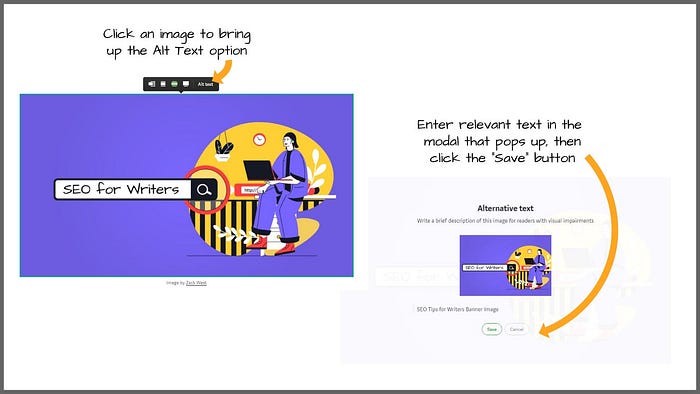These Simple Tips Will Have You Writing For SEO Like A Pro

By Prebuilt Sites Team
October 24, 2022
This article is a perfect crash course for understanding Search Engine Optimization (SEO), and what actions you can take now that will have the greatest impact on your SEO. So what even is SEO? As Medium writer Zack West explains, SEO is a term used by content producers and web developers that describes actions you can take within your content to have your website’s post and pages show up in search engine results, such as Google’s index. There are two types of SEO: on-site and off-site. Off-site SEO refers to your website’s technical SEO that users can’t see. Some ways to improve your off-site SEO is by using both internal and external backlinks on your website, renaming images before upload, setting image alt text, and using captions where appropriate. On-site SEO refers to your content that users can see. Some important key takeaways to improve your on-site SEO are using keywords in your headings, making a good first impression in your introduction, and keeping your paragraphs short and sweet throughout. If you have any questions about writing for SEO reach out to us at Prebuilt Sites or The BBS Agency. We’d love to help you out!
Writing is tough. Writing with Search Engine Optimization (SEO) in mind is even tougher. In this article, we’ll cut through the complexity of SEO for writers and focus on actions that have the greatest impact. We’ll learn how headings, paragraph length, and keywords all influence the reach of, and engagement with, your content.
Search Engine Optimization (SEO) is the practice of creating content with search engine indexing in mind. It helps content appear in search engines like Google for related keywords. Simply put, SEO helps your content find the right audience. In this article, we’re going to walk through the basics of SEO — outlining simple steps to maximize the impact of any writer’s efforts.
Highlights
This article is meant to be a crash course. The SEO concepts and recommendations here are summations of best practices intended to provide maximal impact with minimal effort. For those serious about SEO, I recommend this article. For those writers that despise the idea of SEO, but acknowledge its importance in digital communication — this article is for you. Here’s what we’ll be covering:
- Basic intro to SEO, its impact on digital content, and why you should care;
- Introduction of some key SEO terminology to be aware of;
- Importance of paragraph & sentence lengths
- SEO considerations for images and headings
- The importance of backlinks, both internal and external
- Some parting words of wisdom
Quick Intro: SEO Basics
Search Engine Optimization (SEO) is a term used by content producers and web developers to describe actions taken to encourage indexing and optimal ranking of pages within search engines like Google. There are two segments of SEO: on-site and off-site.
- On-Site SEO: Consideration for headings, Schema Markup, Content length, Reading levels, and related aspects of producing content that is 100% in the control of the content publisher.
- Off-Site SEO: Mostly related to building backlinks, but also concern is given to utilizing external channel tools where possible. Can mostly be ignored by writers and web developers.
SEO helps content find the intended audience. Conceptually, it can be regarded as packaging content in a way that search engines are able to recognize it as relevant to the terms that someone is searching for.
There is nuance to SEO, as well as a degree of complexity. In most cases, writers needn’t concern themselves with anything but the basics of SEO. These concerns will ensure maximal impact from minimal effort and are the focus of the remainder of this article.
Terminology

Concerning SEO, there are a handful of terminologies writers should be aware of. Again, these are not SEO-specific considerations but are very influential to the prioritization of content within search indexes. These simple terms are useful to build a high-level awareness of SEO best practices.
Keywords
Keywords are specific groupings of words within text that reflect both interest and awareness. From a writer’s perspective, these are comparable to prompts, topics, or subject matter. For example, the keyword Senescent Cells will be found within an article titled Senolytic therapies and their Impact on Immunological Function. Much consideration can be given to SEO keywords but, in most cases, writers need only recognize their influence at the most basic level.
Headings
Headings are the big bold words used to organize topical sections of articles. Headings are available to various degrees on different publishing platforms. For example, Microsoft Word provides headings H1-H6, though Medium.com only provides H3 (Title & Little-T), H2 (Big-T), and H4 (Subtitle). Use H2 + H3 headings to reflect a hierarchy in your content. For example, “Headings” is a sub-heading of Terminology because it is the secondary focus of a larger topic.
Basic SEO Tips for Writers

Now that we’re speaking the same language, we can discuss which SEO considerations are the most important. These are the actions any writer can take to ensure their content has the best chance at reaching an intended audience. This is not an SEO guide — this is a crash course. These SEO tips will let you focus on SEO as little as possible while still giving your content a fighting chance in search indexes.
Use Keywords in Headings

Keywords are what allow search engines to associate content with specific searches. When a keyword is in a heading, search engines recognize those keywords as being particularly relevant to an article. In the past, Google actually used headings as ranking factors. That meant writers had to include their keywords in headings if they wanted to rank that content for a certain keyword. That’s not the case anymore, but using keywords in headings is still considered best practice.
Opening Paragraphs Are Critical

Opening paragraphs are like first impressions — writers get one chance to interest a reader. Including the primary keywords in the first paragraph sends a strong signal with respect to an article’s focus. Introductions to a subject have their place — but that place isn’t the opening paragraph.
Opening paragraphs can be compared to abstracts of scientific papers. Abstracts should introduce the subject concisely, briefly discuss the areas of focus, and offer a concise summary of any conclusions one can hope to reach after reading. This is good practice for general writing as well as SEO. Many readers will judge your content by the first 75 words written. Best to make them count.
Paragraph and Sentence Lengths

There is no “perfect length” for paragraphs or sentences. There are cases when a reader will be best engaged by having longer, more detailed, and explanatory sentences are the preferred format. Sometimes shorter sentences are better. A good approach is to be mindful of the average sentence length and average paragraph length in one’s content.
Mixing in shorter and longer content blocks can help develop a sense of rhythm and keep a reader engaged. In fact, mindfulness of one’s rhythmic prose is among the focal points of leading writing tools like Grammarly (a big help for basic SEO awareness.) Sometimes longer sentences are needed to make a point. However, the overuse of long sentences can tire a reader out.
Using tools like blockquote can help pull out relevant snippets, such as letting writers know this section offers SEO tips for paragraph and section lengths, while also breaking up large bodies of text.
Popular tools like Yoast SEO (a WordPress plugin) recommend average paragraphs stick to the 160-word range and sentences stick to the 20-word range. Again, these are only guidelines for averages — no need to count words. In most cases, writers can capture the full SEO benefit of limiting paragraph and sentence lengths by maintaining a broad awareness of when they might be demanding too much of a reader. It’s that simple.
Images, Captions, & Alternative Texts

Images present several opportunities for SEO. Using keywords in an image filename, the alternative text (when available), and captions are great actions to take. In addition, adding links in image attributions is a great SEO opportunity. The overall impact of such links is minimal, so no need to “stuff” keywords there. Branded terms, such as a website or author name, are a good option.
Images provide writers with easy SEO wins such as using keywords in alt text fields, sneaking in a few extra backlinks, and even signaling to search engines that certain content is higher quality because it contains unique images.
In general, search engines are bad at recognizing the subject matter of images. Image analysis is a resource-heavy endeavor by which even the most advanced machine learning algorithms still make silly mistakes. This brings about two important realizations:
- One needs to use keywords in filenames, alternative texts, and captions to explicitly describe to search engines an image’s subject matter;
- Search engines often associate irrelevant images to certain keywords because they have been named, captioned, or linked to by those keywords.
The TL;DR here is that an image should always be named, described, and presented in contextually-relevant syntax. In some cases, these considerations are irrelevant because certain platforms will negate such actions.
For example, the featured image of this article is named seo-tips-for-writers-banner-image.jpg but ultimately gets presented as 1*hsdSlQF-O1YTXTr1JTr_fQ.jpeg in the HTML (what the search engines will see) because Medium’s image processing algorithms rename it.
Internal & External Links
Links, a.k.a. hyperlinks, are essential to SEO. They are so essential that I’ve broken from the hierarchy of subheadings I’ve been using so far — affording backlinks a new H2 heading. Links can be categorized in many flavors: internal, external, nofollow, dofollow, sponsored, etc. The only two that matter for casual SEO are the following:
- Internal Links: links that take readers to URLs on the same domain.
- External Links: links that take readers to URLs on other domains.
Platforms like Medium present a bit of a curveball here: sometimes an internal link can refer to a link that points to an external link on a writer’s website. For example, I might republish an article on Medium after having first posted it to a personal website. That article might have internal links to other URLs on my personal website.
Internal vs. External: Knowing the Nuances
Technically, these would be considered external links within the text on Medium. Practically, they can be regarded as internal links because they point to a website I operate. This is getting into splitting hairs though, which isn’t what this article is about. Let’s focus on the bare minimum SEO awareness one needs to afford to link. These simple rules will help ensure success:
- External links are like endorsements of opinion. These links signal to search engines a deferral of authority to someone other than the current author.
- Internal Links are ways to help signal relevant to other content an author or organization has produced. Internally linking to related content cultivates a broader sense of authority, in the context of search engines, over extended periods of time.
Sometimes deferring authority to an external source is a good thing. Are you referencing medical literature? Deferring to peer-reviewed research is a sign of due diligence and trustworthiness in the eyes of search engines. However, it’s also important to keep in mind your readers’ opinions.
Linking to a credible source while making a false statement will degrade your trustworthiness in the eyes of readers — even if search engines don’t pick up on it right away. For example, I might link to an article in a peer-reviewed journal when I tell you that pigs can fly. The fact this link directs readers to a credible website doesn’t mean it’s accurate.
However, search engines often interpret such links as a signal of higher editorial integrity. Part of being SEO fluent is knowing when not to take advantage of SEO hacks at the expense of real-world authenticity. Just because search engines can’t spot these nefarious hacks today doesn’t mean they won’t be able to in the future — at which time content having partaken in such shortcuts will likely be penalized.
Medium Tip: Use Canonical Links When Relevant

As a final consideration for SEO links, it’s important to take advantage of platform-specific features. For example, Medium allows writers to add a canonical SEO link for their article. This means that Medium.com will tell Google that the original source of an article is a different URL.
That way, authors can re-post content from their personal blogs, business, or organizational websites without worrying about losing any of the SEO value of that content. In fact, re-posting to Medium and adding a canonical link to the original article URL is a great way to give that page an SEO boost.
While subtle, this actually has profound implications on how search engines detect copyright infringement, syndicated content, and duplicate pages. If you are writing solely on Medium this should be of no concern. For business, however, this presents a unique opportunity to re-publish content to Medium without worrying about how that might affect search engine rankings for pages on their website.
Discussion
SEO is in many ways like grammar for search engines — a lifelong study of SEO would certainly allow one to better understand the finer points but basic working knowledge is enough to be successful. In most cases, writers will be more impactful by focusing on the quality of their content. Keeping basic SEO concepts in mind while writing is likely enough for the majority of cases.
SEMRush, an enterprise-grade SEO toolkit for digital marketers, publishes an annual ranking factors report. This report details the most statistically significant factors that influence how content ranks in search engines. After direct website visits, the single most important SEO ranking factor is time-on-site. No amount of SEO will keep a reader on a page if they don’t regard the content as high enough value.
With this in mind, I am of the opinion that all content should be created first with quality in mind and with SEO considerations made second. In many cases, best SEO practices align strongly with best practices for general writing. Perfect paragraph lengths won’t cover up low-quality content for long.
Final Thoughts
SEO is a broad area of concern in which one can have as nuanced a focus as desired. When it comes to writing, simple consideration for SEO offers enough impact for most all content. Solid introductory paragraphs, sensibly sized paragraphs, and logical use of headings will do more than all other SEO combined. Search engines are only getting smarter and, eventually, good SEO will overlap completely with good writing. Until then, keeping these simple tips in mind will serve any writer well and help their content compete more successfully in search engine results pages.
Originally posted on Medium by Zack West.

